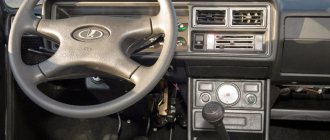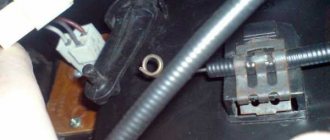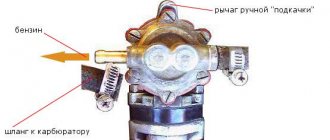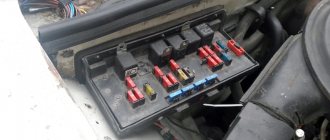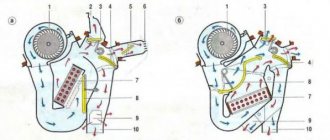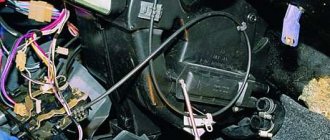Before the onset of cold weather, every responsible driver carries out a preventive inspection of the car and eliminates possible malfunctions. Most often, oil and antifreeze are changed regularly, and the car tires are changed to winter ones. The stove, which is one of the main units of the car, which provides comfort for the driver and passengers in the cold season, also requires special attention.
Heater regulator on the dashboard of a VAZ-2107 car
This article will discuss the design of the VAZ-2107 stove and its correct configuration for high-quality heating of the interior.
The design and principle of operation of the VAZ-2107 stove
In order to carry out preventive maintenance of the heating system of the vehicle interior and correctly configure its operation, you must first understand the structure of the VAZ-2107 stove.
The stove in the seven is located in the cabin and is attached to the partition of the engine compartment with four fasteners. A rubber seal is installed between the motor and the stove. Air arrives to the stove through special holes in the hood. At the rear of the heater in the engine compartment there is an air supply box. The air passes through the radiator, where it is heated, and enters the car either under the pressure of cold air from the street at high speeds of the car, or under the action of a fan, which creates air movement under pressure. The fan has three operating speeds: neutral, low and high. The fan speed switch is located on the dashboard of the car.
A visual diagram of the operation of the VAZ-2107 heater
The heater radiator uses liquid from the car's cooling system to function. The amount of hot liquid that enters the radiator can be adjusted using the tap. It is located near the floor of the vehicle on the passenger side and comes from the flexible rod control lever. The control lever is located on the dashboard of the vehicle. The top heater switch controls the heater tap. In the extreme right position, the switch fully opens the tap, allowing the maximum possible amount of coolant to enter the radiator. In the switch position on the left, the tap is closed, antifreeze does not enter the radiator, and the stove remains cold.
Exterior view of the heater radiator of a VAZ-2107 car
The heater motor is located under the radiator. A resistor is included in the electrical system of the motor, which makes it possible to switch fan speeds.
Under the action of the fan, warm air flows through the tubes towards the side windows, to the windshield and to the deflectors. Using deflector grilles, you can change the air supply route for directional airflow. Hot air is controlled by opening or closing the stove damper, the lid of which is adjusted by flexible rod levers. The middle lever is responsible for closing the air supply hatch. In the extreme right position of the switch, the maximum possible amount of air from the street enters the car. In the extreme left position and the lid is tightly closed, air does not enter the cabin.
The lowest lever is responsible for the distribution of air flows. The right position of the lever ensures maximum air supply to the side windows of the car, the left position ensures blowing of the windshield.
A detailed diagram of connecting the ventilation and heating system of the VAZ-2107 can be found in the technical documentation for the vehicle.
Control mechanism
The control of the VAZ 2107 stove is mechanical. It consists of a fan switch and a block of sliders. The control mechanism is installed on the center console at the top, which provides easy access to the elements.
There are three sliders of the control mechanism, and each of them controls its own element:
- The top one is responsible for supplying antifreeze to the radiator and is connected by a cable to a tap installed on the inlet pipe. The extreme left position of the slider means the tap is closed (the stove does not heat), the right position means the tap is open (antifreeze enters the radiator).
- Middle – air supply damper control. When you move it to the left, the damper shuts off the air supply from the street (closed air circulation in the cabin), while the right position means the air flow is open (air from the street enters the cabin).
- The lower one controls the damper for distributing the flow through the air ducts. Left position - the flow is supplied through the side and central deflectors, right - to the windshield area. Each of these sliders can be adjusted to any position to achieve optimal stove operation.
Common stove malfunctions and options for eliminating them
Before the onset of cold weather, it is imperative to check the functioning of the main elements of the VAZ-2107 heater.
Most often, the following malfunctions occur in the interior heating system of the seven:
- Poor quality connection of pipes and air supply pipes.
- Radiator and heater tap leaking.
- Malfunction of the electrical equipment of the stove - oxidation of the wires, failure of the motor or fuse of the stove. The fuse is located in the block under the hood of the car. The fuse box is located on the partition between the passenger compartment and the engine compartment on the passenger side.
Even a novice driver can fix such malfunctions in the heating system. More serious breakdowns may lead to the need to purchase a new stove.
First you need to conduct a visual inspection of the heating system parts. To do this, you need to disassemble the stove and clean it of particles of debris and dust collected over the summer.
Debris and dust accumulated during operation on the radiator of a VAZ-2107 car
One of the most common problems in the heating system of the VAZ-2107 is poor-quality sealing of the stove air ducts. This problem can be eliminated by treating the cracks in the plastic elements of the heater housing with silicone. Also, the holes near the pipes must be sealed with rags. Eliminating the holes will reduce the loss of warm air and will result in faster heating of the interior.
The next step is to check the heater and radiator valves for leaks. This is the main headache for owners of domestic cars. If the stove faucet or pipes are leaking, they must be replaced with new products. At the same time, the sealing butt gaskets are also changed. If the radiator itself is leaking, then there are two options for solving the problem. Most often, sevens have an old-style copper radiator installed. A copper radiator can be soldered and thus extend its life. If the seven is equipped with an aluminum radiator, then it cannot be repaired and must be replaced with a new product.
If, after carrying out all the preventive manipulations, cold air enters the cabin, the reason may be a clogged radiator, then it will need a thorough cleaning. Experts recommend carrying out preventive radiator flushing at least once a year. At the same time, all hoses and pipes are washed.
For preventive purposes, it is important to inspect the stove wiring for oxidation or poor contact insulation in order to avoid short circuits, burnout of the motor and heating system fuse. If the stove is working, then a visual inspection and troubleshooting is sufficient. Otherwise, it is necessary to check the functioning of the electrical circuit elements using a tester.
Such simple manipulations will save you from unpleasant situations with the heating system during the cold seasons.
Reasons for decreased performance
In addition to obvious malfunctions due to which the stove does not work or functions incorrectly, there are other problems with the heating system of the VAZ-2107 interior. The main one is a decrease in stove performance.
If the stove heats poorly, then the reason lies in:
- Malfunctions of the power plant cooling system (reduced pump performance, stuck thermostat).
- Radiator clogged.
- Formation of an air lock in the heater radiator.
- The air intake damper seal is worn out.
To find the cause of decreased performance, start by checking the heating of the heater radiator. To do this, heat the engine to operating temperature, fully open the antifreeze supply valve to the stove and hand check the degree of heating of the supply pipe before and after the valve and the radiator itself. If the pipeline is hot before the tap, but not after it, the tap is jammed. If the radiator does not warm up, the reason lies in severe clogging of the heat exchanger or a plug in it. If the pipeline does not warm up even to the tap, inspect the cooling system.
We recommend: Temperature sensor Volkswagen Passat B3: where are they located, replacement
If the radiator warms up well, but it is noted that the stove heats worse, then check the functionality of the air intake damper and the condition of its seal. It wouldn’t hurt to check the stove body and air ducts for leaks and cracks.
To ensure that the VAZ-2107 heater heats well, before the winter period check the functionality of the tap, replace the antifreeze (with flushing the system), inspect the control mechanism and the functionality of the dampers.
Stove modernization
Very often, in parallel with the prevention of stove malfunctions and its settings, the driver modernizes the heating system for more efficient operation.
Most often, for these purposes, the standard fan and resistor are replaced with products from the figure eight. The new fan is larger in size, due to which a larger amount of warm air is supplied, and the vehicle interior warms up faster. The new fan fits into the standard seat with virtually no modifications. It is only necessary to cut off one of the aerodynamic ridges from the impeller. After such improvements, it will also be necessary to replace the standard fan button with a product from the figure eight.
Sometimes, for better airflow of the driver’s side windows, additional small fans are installed in the deflectors. Such improvements, combined with preventive maintenance, will ensure comfort and warmth in the cabin even in the coldest times.
Nozzles
A nozzle, or deflector, is a device through which air enters directly into the cabin. The heating system of the VAZ-2107 includes four deflectors: left, two central and right. A special feature of the nozzle design is a mechanism that allows you to change the position of the lamellas inside it, redirecting the air flow from side to side, and also block it altogether.
Let's sum it up
Timely diagnostics, preventive cleaning and inspection of elements of the vehicle’s heating system is a guarantee of high-quality operation of the stove. Experts recommend checking the heating system on the VAZ-2107 at least twice a year - in autumn and spring. Any driver can handle preventive cleaning and adjustments of the stove on his own; to do this, you just need to understand the structure of the heating and ventilation system of the cabin and the principle of its operation. The easiest way to do this is to always have a visual instruction manual for your car nearby.
Don’t put off any further work to improve the functioning of your car’s heating system. Proper care will ensure uninterrupted operation of the heater and a comfortable temperature in the interior at any time of the year.
Control module
The heating system of the VAZ-2107 is controlled using a special module located at the bottom of the dashboard. Its design includes three levers and a heater fan mode switch.
The topmost lever controls the “stove” tap. In the extreme left position it is closed, and the coolant flows bypassing the heating radiator. If the switch is moved all the way to the right, the refrigerant will begin to flow into it in full, heating the air to the maximum.
The middle lever allows you to close and open the air supply cover. In the left position it will be completely closed and outside air will not be able to enter the cabin. The lid will open completely when we move the switch to the far left position.
The heating system of the VAZ-2107 provides for the distribution of air flows for blowing the windshield and front side windows. This is done using the lower lever. In the right position, the air is directed to the side windows, in the left - to the windshield.
The heater valve, air supply cover, as well as dampers that redirect air flows are driven by cables.
The fan mode switch is located to the left of the control levers. It has four positions in which the fan:
- switched off;
- works at first speed;
- at second speed;
- at third speed.
The most common problems
Thanks to its simple design, the heater of the 2107 VAZ model rarely breaks down. However, sometimes failures do happen. Most often this happens due to:
- sour faucet;
- clogged or cracked radiator;
- breakage of the cable drive.
It is the first of the mentioned elements that causes the greatest problems. The trouble is that in the winter the VAZ stove is actively used, while in the summer, of course, it sits idle for 4-5 months. Because of this, the tap often becomes clogged with solid particles contained in the antifreeze and jams. With the arrival of cold weather, it can be very difficult to open it, which is why the cable breaks or the locking fitting itself breaks. The faulty unit must be replaced.
The period of inactivity is also negatively displayed on the radiator. Without coolant circulation, deposits form on the coolant walls and oxidative processes are activated. As a result, the heat exchanger tubes become clogged, and subsequently the efficiency of the furnace as a whole decreases.
For preventive purposes, the radiator must be regularly washed with special compounds. Blockages are removed mechanically.
Leaks are another problem that often occurs with heaters. They occur due to the destruction of the faucet or loss of tightness of the joints of the pipes and radiator. The first two breakdowns are eliminated by replacing the failed element, and the last – by soldering. Fortunately, the original radiators on VAZ classics are made of copper, and therefore can be easily repaired.
Sometimes the fan also breaks. Problems here arise due to:
- motor burnout;
- wire break in the circuit;
- button failure.
Repair of heating radiator VAZ 2107
Often, repairing a VAZ 2107 stove involves replacing or repairing the heater radiator. Repair actions depend on the type and cause of the malfunction:
A clogged radiator can be flushed with water pressure. Scale on the walls of honeycombs can be removed using a special product that dissolves it.
A leak in a copper (brass) radiator can be soldered. Using a powerful soldering iron and solder, you can repair a hole or crack. Leaking aluminum radiators must be replaced.
Other problems with the heating system
Although heater radiator breakdowns occur most often, there are other malfunctions that can be easily fixed with your own hands:
- Fan motor failure. Problems are created by the rotor bushings, which on the “original” motor are made of low-quality material. As soon as the heating system fan begins to whistle, it needs to be replaced with a non-original one, in which bearings are installed instead of bushings.
- Heater valve wear. It suffers from scale, dirt, and simply wears out. Cranes are usually not repaired, but replaced. It is better to replace a faucet with a ceramic core; it is much more reliable and durable than a metal one.
- Breakage of control unit rods. Everything is clear here: what should be regulated is not regulated - check the condition of the rods and their connection. Sometimes the problem is solved in just half an hour.
More complex work, such as tuning or modifying the stove, is no longer considered troubleshooting. Of course, the stove on a VAZ opens up endless possibilities for improvements and additions, but you can get by with what you have at the moment. The main thing is that everything works as it should, and then you definitely won’t freeze in winter.
It is better to check the heating system before the time comes to use it. In the summer it is more comfortable and easier to do repairs; you can take your time and look for high-quality and inexpensive spare parts, and generally come to the cold season fully armed. In most cases, when the VAZ 2107 stove does not heat, you can correct the situation yourself. You just need to have straight hands and the desire to do the repairs correctly and efficiently.
Interior ventilation
Outside air can enter the vehicle interior:
- with the door windows down;
- through the upper nozzles on the instrument panel, if you move distribution lever 7 (Fig. 9) and lever 6 for controlling the air supply hatch cover to the right;
- through the side nozzles 1 on the instrument panel, if you move lever 6 to the right and lever 7 to the left;
- through the holes of the heater casing, if you open the heater cover with lever 9 and move lever 6 to the right;
- through the central nozzles 4 directly from the air supply box when the car is moving, if the regulators 2 open the nozzle flaps (summer airflow).
By moving lever 3 in the horizontal and vertical directions, the direction of the air flow from the nozzle changes.
In the middle position of lever 7 and in the right extreme position of lever 6, air will flow through both the top and side nozzles.
If the vehicle is moving at low speed, you can increase the amount of incoming air by turning on the electric heater fan with switch 10.
Interior heating
To heat the car interior and protect the windshield, front door glass, and rear window from fogging and freezing:
- move levers 5 and 6 to the right;
- set lever 7 to the middle position;
- open the heater cover with lever 9;
- turn on the heated rear window;
- turn on the electric heater fan if necessary;
- Install the guide vanes of the side nozzles so that the air flow is directed towards the front door windows.
Warm air will be directed both to the driver’s and passengers’ footwells and to the windshield and front door windows. To heat only the windshield faster, close the heater cover and move lever 7 to the right.
Anti-fog protection for windshield, front door glass and rear window
To protect the windshield and front door windows from fogging, it is enough to direct cold air onto them, for which:
- close the heater cover with lever 9;
- move lever 6 to the right, and set lever 7 to the middle position;
- Install the guide vanes of the side nozzles so that the air flow is directed towards the front door windows.
If you need to warm up the incoming air a little, move lever 5 of the heater valve control partly to the right. If necessary, turn on the electric heater fan.
To protect the rear window from fogging, turn on its electric heating with switch 8.
Injector and carburetor: is there a difference in the design of the heating system
The heating system of the VAZ-2107 (injector) is no different from the one that was equipped with the old carburetor “sevens”. Their designs and operating principles are absolutely identical. Radiators, their taps, electric fans and all other elements are interchangeable. The only way the heating system of the VAZ-2107 (carburetor) may differ is the material used to make the “stove” radiator. The old "sevens" had them made of copper.
